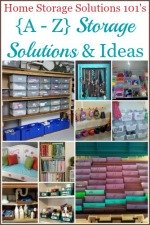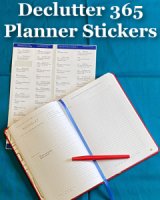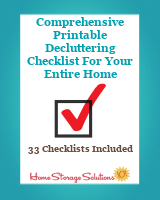
Stockpile Organization & Storage Tips

Below I've gathered my and other readers best stockpile organization and storage tips, plus photo ideas of how you can keep the items you've purchased at their rock bottom prices organized and easily found, so you'll actually use them.
If you shop sales and coupons at all you've most likely begun to accumulate a stockpile. These stockpiles can be either for food or non-food types of items. Stockpiles make sense when you can buy enough of a product at a low price to make it worth your time and effort to store and organize it all in your home until the next sale comes around again.
The Danger Of Stockpiling: It Can Become Clutter
Keeping a large amount of items in your home for future use can be a good stewardship of your monetary resources, but if you're not careful it can instead easily become clutter.It's a fine balancing act sometimes, but if you can't find what you purchased and then have to repurchase more later, or items expire before you are able to use them you've got clutter, not a functioning stockpile.
Therefore, before you begin organizing your stockpile, go ahead and first declutter your stockpile, as discussed further in this Declutter 365 mission here on the site.
Then, after you've decluttered you'll be able to take these steps to organize and manage your stockpile that are discussed below.
How To Organize Your Stockpile To Keep It Useful
Here's my tips for making your stockpile useful through organization. Photo courtesy of Steph, who purchased all this for $70
Photo courtesy of Steph, who purchased all this for $70If you're not careful your stockpile can just be a bunch of stuff piled somewhere, which quickly feels like or is clutter. But taking steps to organize it as you bring things in the door will help immensely!
Only Store Items In The Space You Have Available
I think we've all seen an episode or two of Extreme Couponers, and a few of these people's houses look like a cluttered grocery store or a bunker to hunker down in case of emergency. There is stuff stored everywhere. That is not ideal.You need to designate a spot, or a few key spots, for your stockpile and once those spots are filled, you've collected as much as you can keep in your home until you use some of it.
Remember, there is a difference between having enough to use within a reasonable time, bought at a good price, versus hoarding such large amounts that you'll not realistically use all of the stockpile in the next ten years!
If you find you have way too much of something please go ahead and donate the excess to charity or re-sell it before it expires or gets so old no one will want it. Then, stick to the space you've designated for these items without expanding your stockpile out further.
Shelves Are Ideal: Think Like A Grocery Store
You won't have as much stuff as an actual grocery store, but the ideal way to stockpile, if you've got room, is to have a space designated with sturdy shelves that are secured to the wall where you can place many of your items.You want to group like items together so you can find them, such as all paper goods, laundry supplies, cleaning supplies, personal care products, food items, etc., grouped together in their designated spots.
Line items in rows, keeping things neat and orderly. This allows you to "see" what you've got so you know when you have enough, and don't need to stockpile more of an item, and also to access it when you do want to use it.
Think Of The Location Or Locations Of Your Stockpiles
Shelves can be placed in many different places in your home, such as a basement, garage, utility room, or more.If you don't have room for shelves you can also just use places like under beds, linen closets, or a shelf or two of the pantry. Typically in those situations
No matter where you choose to hold your stockpile though, you need to think about the conditions. For example, basements can be damp, and that may not be ideal for certain food items.
Similarly, the garage can be a good place for some of your stockpile, but think about the temperature extremes, which can cause food spoilage, as well as access to different areas of your home by pests.
Only keep items in a location where they'll not deteriorate in quality from being stored there. There is no point in accumulating a lot of items if your storage method ruins them before you have a chance to use them!
In addition, ideally your stockpile will be in one or two locations instead of spread out all over the house.
Some people separate their food and non-food stockpiles, which is fine. But again, having just a few locations to check is important.
I understand that depending on your home's layout and space available having just one area designated for your stockpile may not be enough.
If you need to separate items into groups, try to make it make sense where you place things as much as possible, such as personal care products in the bathroom closet, or canned goods in the pantry, etc.
What you don't want to happen is to stash a large quantity of something somewhere, and then completely forget about it. That is wasting, and clutter. That's why the fewer places you keep these items the better to make sure you don't forget what you have.
Rotation, Rotation, Rotation!

This is even more important for food items, such as a reader, Meg's pantry, where she considered this exact issue with her can rotators, for example. But really anything can expire or just plain get old. Obviously, things like paper goods last much longer then certain food items, but just get in the habit of always rotating everything you purchase to avoid problems or wasting.
When you come back from your shopping trip go ahead and take the time to place things neatly on shelves or in bins to keep with your organizational system. Also make sure you add the newer items to the back of the shelves, while moving the older items to the front for easy access.
Keep A Rough Inventory Of What You've Got Stockpiled
The whole point of stockpiling is to actually use what you've purchased eventually. All of the organizational methods above will help you do this.In addition, keeping an inventory will also help you use what you've got. An inventory provides you with the information necessary to know when you should stop purchasing items because you've got enough versus when to know it is time to start looking for deals and coupons again to stock back up on something.
Your inventory can be rough, and I don't think it needs to be precise. If you use the methods above of keeping things grouped together with like items, especially if it is on shelves, just a quick glance can tell you the information you need to know about what you already have.
Below I've gathered pictures from readers of real life stockpiles to show you how you can keep yours organized and make sure it is a way you're saving money, and being prepared, instead of just accumulating clutter in your home.
The top picture, above, is from a reader, Krystal. She keeps her stockpile in a small closet in her bathroom and has both things organized on shelves, but also has created containers for the main categories of items she has stocked up on.
She explained, "I stockpile so this helps everyone find what they need." You can organize like Krystal too! Get more ideas below!

Sturdy Shelves Are Important Because Of The Weight Of Stockpiled Items

This photo is from a reader, April. She keeps her paper goods and laundry and cleaning supplies on shelves in her utility room.
For that reason very sturdy shelves are important, instead of flimsy ones.
If you've got some that aren't as strong and sturdy save them for use with paper goods, which are bulky but much lighter in general.
In addition, since these shelves will be heavily loaded make sure you properly secure the shelves to the wall so it is safe.
Display Stockpile On Shelves Like In Grocery Store

As I mentioned above one of the best ways to organize your stockpile, if you've got room, is to set up shelves.
Here are several examples from readers who've done just that. Notice how they've grouped like items together, and lined everything up so it is easily seen.
This makes it easier to stock the shelve after a shopping trip, and to "shop" the shelves as you run low on an item and want to use a new one from your stockpile.
The picture above is from a reader, Theresa.
In addition, here's some more pictures. This one, below, is from Anna who said, "Love my coupons!"

Similarly, here's another example. This photo below was provided by Suzanne who said, "Some of the stock pile."

Cabinets Can Also Work Plus They Hide Your Stockpile

One complaint, beside lack of space, that people have with shelves for holding their couponing stockpiles is that they don't like to have it all so visible.
If you feel this way you could use cabinets instead. They obviously have doors which you can close so you can't see all of the items.
The photo above is from a reader, Tracy, who says: "I have a 2 door cabinet with mostly personal care things in plastic containers marked with P-touch tape. The paper goods are on the outside top shelf. I have another cabinet for anything other than personal care."
Here's another example of a reader using cabinets for stockpile organization, from Natalie, who said: "Here's mine. New cabinets keep it organized."

Note that just like with shelves, keeping like items together and keeping thing neat and in rows can make everything much more organized and easier to access.
In addition, the same caution applies to cabinets, such as these storage cabinets shown below, as to shelves. Make sure whatever you are using is sturdy enough for the weight of your stockpile, and don't overfill shelves past their capacity.
Smaller Stockpiles Can Be Stored In Closets

If you don't have room in your home for either dedicated shelves or cabinets for these items another option is to use all or part of a closet.
The picture above is from a reader, Lyn, and she has added baskets to contain and organize the items within her stockpile in her closet. She explained, "I stock up on band-aids, decongestant, alcohol, aspirin, ibuprofen etc. It's a very small closet."
Here's another example, from a reader Kylie, who has a small amount of products she stocks up on, and so she just uses one shelf in her linen closet.

So how do you organize and store items for your couponing stockpile? I'd love to see what you do. You can submit your photos here and the best ones will be added to this page.
More Home Storage Solutions
I hope you enjoyed these ideas for organizing and storing your stockpile.There are even more ideas for storage and organizing on the site in the {A-Z} Storage Solutions & Ideas round up page. Go check it out if you'd like to see even more ideas.
In addition, if these ideas have inspired you to organize even more things related to couponing make sure to read the Organize Coupons Challenge, which is part of the 52 Week Organized Home Challenge I run on the site!

Three collage photos for how to image provided by a reader, Amanda
Some links on this page are affiliate links, meaning that if you purchase a product through them I receive a small commission which helps me provide this information to you for free, plus support my family. My integrity and your satisfaction are very important to me so I only recommend products I would purchase myself, and that I believe would benefit you. To learn more please see my disclosure statement.
Related Pages You May Enjoy
Join The 52 Week Organized Home ChallengeGetting Rid Of Pantry Clutter Hall Of Fame
Go From Stockpile Organization & Storage Tips To Home Page
Comments for Smaller Stockpiles Can Be Stored In Closets
|
||
|
||
|
||
|
||
|
||













